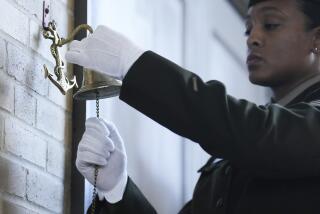Volunteers Target Civil War Database
- Share via
SALT LAKE CITY — Terry Moyer leads a corps of highly dedicated volunteers in benevolent assault on the Civil War armies of the North and South. And he’s winning.
So, too, are the United Daughters of the Confederacy, the Federation of Genealogical Societies, the National Park Service and, not least, up to 100 million Americans with Civil War ancestors.
Moyer and his self-styled “Utah Army Corps” of 440 volunteers are playing the decisive role in a vast, six-year Park Service project: placing on computer the name, rank and unit information from 5.4 million records of Civil War soldiers’ service.
“The real heroes are all over the country,” ordinary people who have volunteered to help, says Moyer, a former high school history teacher whose great-grandfather was a Pennsylvania volunteer in the Union Army.
The data entry--now 80% complete--pares duplicate soldier index cards in the National Archives. That will leave the Park Service with a database of the approximately 3.5 million Civil War combatants, their regiments and rank when mustered in and out.
As the compact discs are completed, they are edited for accuracy, state by state, at the Mormon Church’s Family History Department. Then they are delivered to the Park Service, which puts them on its Internet Web site and in visitor centers at the 30 Civil War parks it manages.
First to be completed were the names of 235,000 black Union soldiers so they could be added to the African American Civil War Memorial, scheduled to be dedicated later this year in Washington, D.C.
The completed Civil War Soldiers and Sailors project should be delivered to the Park Service by the end of 1999, said David E. Rencher, project director for the Church of Jesus Christ of Latter-day Saints and current president of the Federation of Genealogical Societies.
By accessing a name on the Civil War Soldiers and Sailors list, a researcher or descendant can learn the regiment in which he served. That makes it possible to order copies of the soldier’s military and pension records.
Rencher did that last year after visiting the grave of his great-great-grandfather, Alfred Brenner, in Pennsylvania’s Lancaster County and learning he had served in the Grand Army of the Republic.
The records Rencher received from the National Archives were a genealogist’s bonanza: Brenner’s date and place of birth, height, color of hair and eyes, date and place of marriage and the names and dates of birth of his wife and four children, two of whom died relatively young.
Among other things, Rencher discovered that 19-year-old Pvt. Brenner was discharged from the 122nd Pennsylvania Volunteers in Harrisburg in May 1863 due to health problems--six weeks before and 35 miles removed from the Battle of Gettysburg. He died in 1928 at age 85.
“You can see how the American public will now have access to a ton of information it never had before,” Rencher said. “So many people know that ancestor so-and-so fought in the Civil War, but they haven’t a clue what regiment he was in. And if you don’t have the regiment, you can’t get all this other information.”
Utah, then a territory, mustered in just 96 soldiers on the Union side. The 1st Utah Cavalry guarded telegraph lines. “They did that for a few months before they learned the Indians weren’t interested in telegraph lines,” Moyer said. “So they said, ‘Why don’t we go home?’ And they did.”
Today, Utah’s Mormons, who have a rich heritage of genealogy, have been mainstays in the effort to log Civil War combatants. They’ve done three-quarters of the data entry to date.
“There’s no way we could have done it at the Park Service without the support from the Mormon Church and also the Federation of Genealogical Societies,” said John Peterson, project manager for the Park Service.
At a commercial data-entry rate of $1 per card, genealogical society and Daughters of the Confederacy volunteers around the country have saved the Park Service $5.4 million; the Mormon Church provided its software program and editing services free.
And last fall, when the Park Service ran out of funds to complete transfer of microfilm records to paper so volunteers could enter data on their home computers, Mormon Church leaders chipped in the $35,000 needed to keep the project going.
Moyer, who has entered 170,000 index cards himself, organized his volunteers in 41 regiments. Each then earns rank based on the number of cards entered. Some regiments have half a dozen generals.
More to Read
Sign up for Essential California
The most important California stories and recommendations in your inbox every morning.
You may occasionally receive promotional content from the Los Angeles Times.













